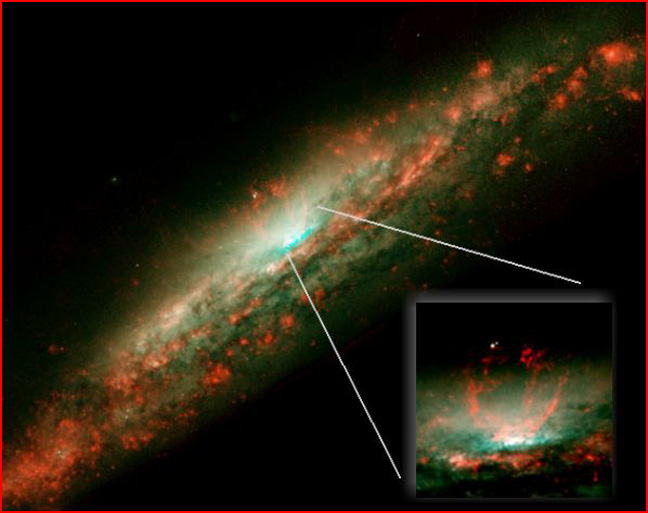|
|
||
 Credit: Gerald Cecil UNC/Chapel Hill et al., NASA |
||
|
pic of the day Links:
Society for
|
Oct
26, 2004 A common characteristic of the spiraling Birkeland currents in a plasma discharge is that they flare out at the top. They appear first as horns or a crescent atop the pillar of the most intense part of the discharge. Often matter will accumulate along the axis as well, making the horns appear as a trident. Occasionally, three or four or more currents will produce multiple filaments flaring away from each other. The flaring filaments above the center of NGC 3079 (image above) illustrate this behavior. They are evidence of a galactic-scale thunderbolt discharging its energy in the core below. Because that thunderbolt is only part of an electrical circuit that encompasses the entire galaxy, we would expect to see signs of excitation in other parts of the circuit. And we do: The outer edges of the spiral arms are dotted with bright spots, traditionally called "star-forming regions." Here the return current from the axial discharge, pinched into more or less equally spaced pairs of filaments, bends into the equatorial plane. At the bend, electrical forces are strengthened and matter accumulates. Stars are indeed formed, but they are electrical stars, lit by the surge of current exploding from the nucleus. Why is NGC 3079 excited? The Electric Universe would suspect the driving energies were due to a surge in a larger, invisible circuit connecting to other galaxies. Mapping the radio and x-ray intensities in NGC 3079's neighborhood may reveal linkages to the galaxy's "parent". That galaxy would have ejected NGC 3079--but before it grew to its present size--in a similar electrical surge. Now NGC 3079 is in turn ejecting its own offspring: Halton Arp has identified nine high redshift quasars associated with this galaxy, and he is investigating 3 more probable quasars, each of which completes a pair with an already-identified quasar on the opposite side of the galaxy. The active galaxy’s electrical characteristics go hand-in-hand with its family of aligned quasars, both here and in other active galaxies. These associations offer valuable clues about the behavior of plasma in space. Universe: Part 1, Cosmology Quest and Part 2, The Spears of Odin, is a two-hour documentary featuring Halton Arp, Fred Hoyle, Geoffrey and Margaret Burbidge, Anthony Peratt, Eric Lerner, and others who support intrinsic redshift and/or plasma cosmology. You can see previews and purchase the DVD at: |
|
|
Copyright 2004: thunderbolts.info |
||
